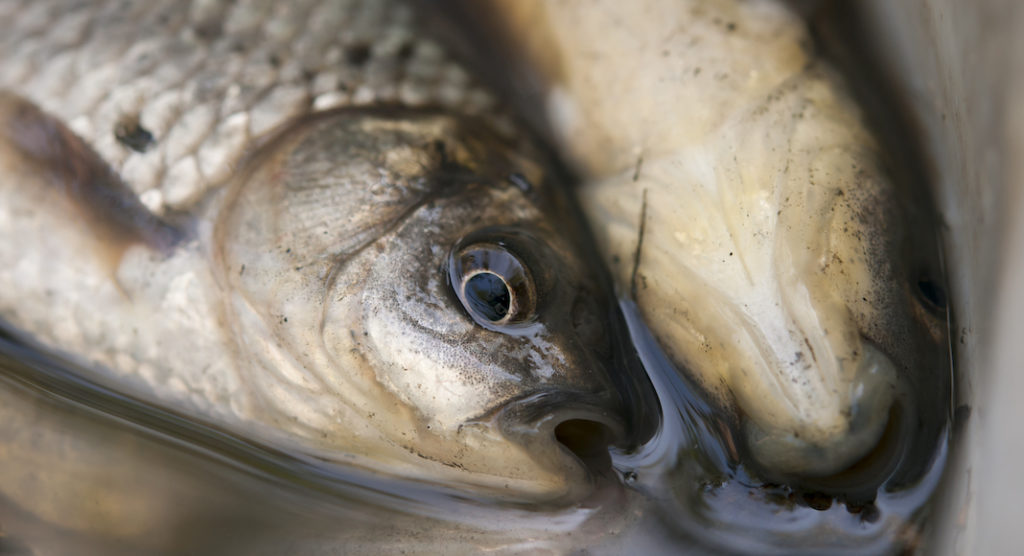
Texas Border Business
AUSTIN – The Texas Parks and Wildlife Department (TPWD) received a report in late June that an invasive silver carp had been spotted in Choctaw Creek, a Texas tributary of the Red River approximately 15 miles downstream from Lake Texoma. A bow angler, Stephen Banaszak, first reported the finding and two specimens were provided to TPWD and the U.S. Fish and Wildlife Service (USFWS) who confirmed they were silver carp.
“These are the first reports of silver carp from Texas waters, although they have previously been found in other areas of the Red River including just downstream from Lake Texoma in Oklahoma waters in 2019,” said Dan Bennett, TPWD fisheries management biologist. “Invasive carp pose a significant risk to Lake Texoma’s ecosystem and boaters and there is adequate flow and upstream river area for them to become established and reproduce in the lake if introduced.”
Previously, bighead carp, another closely related invasive species, had been documented in the Red River and tributaries downstream of Lake Texoma. In addition, bighead carp were documented in the Sulphur River downstream of Lake Wright Patman and Big Cypress Bayou downstream of Lake O’ the Pines. To prevent the spread of these invasive species, which look much like shad when small, the Texas Parks and Wildlife Commission passed regulations making it illegal to transport any live nongame fish from these water bodies. Anglers are urged to follow these rules to prevent introducing these species to other water bodies when using them as bait.
“These invasive carp are not native to the U.S. but have been introduced and become established and problematic in numerous states, primarily in the Mississippi River Basin. Both of these invasive carp species are filter feeders and have the potential to cause significant changes in native fish populations by competing with other filter feeding fish species such as shad and buffalo, and even larval sportfish that also rely on plankton as a food source in their first couple of months,” said Monica McGarrity, TPWD Senior Scientist for Aquatic Invasive Species. “Silver carp can also pose a risk to humans, as they can jump up to 10 feet out of the water when startled by the sounds of watercraft, often jumping into boats, sometimes injuring boaters. When present in large numbers, jumping silver carp can be a significant hazard.”
Young silver and bighead carp are similar in appearance to shad but can be identified by their low-set eyes—shad’s eyes are located near the top of their heads—and the lack of a long, whip-like segment on the dorsal fin. Silver and bighead carp are also similar in appearance to each other, but silver carp have silver, rather than gray, bodies and a ‘keel’ or ridge that runs the length of the belly from the anal fin all the way to the throat, whereas the keel on bighead carp stops at the pelvic fin. Both species can grow quite large, with silver carp reaching approximately 3 feet in length and nearly 60 pounds and bighead carp reaching up to 4 and a half feet in length and nearly 90 pounds. Both species are easily confused with shad or even minnows when small.
TPWD, in collaboration with the Oklahoma Department of Wildlife Conservation, Arkansas Game and Fish Commission, and USFWS, is currently working with researchers at Texas Tech University and Auburn University to conduct research on invasive carp. The project will assess the population status and distribution of bighead carp and silver carp across the Red River Basin, including the Red River downstream of Lake Texoma and the Sulphur River, a major Red River tributary, downstream of Lake Wright Patman. The project will also collect baseline data on native fish populations that may be negatively impacted by the invasive carp.
Anyone who catches either silver or bighead carp in Texas waters is asked to report the sighting with location information and photos to AquaticInvasives@tpwd.texas.gov. Silver and bighead carp are prohibited exotic species in Texas and must be killed upon possession by beheading, gutting, gill-cutting or other means or placed on ice. Neither species can be possessed live.
For more information on silver and bighead carp, visit the USGS Nonindigenous Aquatic Species database webpages below:
Silver carp: https://nas.er.usgs.gov/queries/factsheet.aspx?SpeciesID=549
Bighead carp: https://nas.er.usgs.gov/queries/factsheet.aspx?SpeciesID=551
Regulations for the possession and transport of exotic aquatic species can be viewed in the Outdoor Annual.















